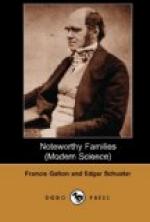______|_________|_______| | | | | | | | | Mean | 111 | 108 | 49 | 61 | 329 | |_____________________
_|________|________|________|_________|_______|
Table VII., in the next chapter, affords an interesting illustration of the character of the ignorance concerning the noteworthiness of kinsmen in distant degrees, showing that it is much lessened when they bear the same surname as their father, or even as the maiden surname of their mother. The argument is this: Table V. has already shown that me bros are, speaking roughly, as frequently noteworthy as fa bros—fifty-two of the one to forty-five of the other—so noteworthiness is so far an equal characteristic of the maternal and paternal lines, resembling in that respect nearly all the qualities that are transmitted purely through heredity. There ought, therefore, to be as many persons recorded as noteworthy in each of the four different kinds of great-grandparents. The same should be the case in each of the four kinds of great-uncles. But this is not so in either case. The noteworthy great-grandfathers, fa fa fa, who bear the same name as the subject are twice as numerous as the me fa fa who bear the maiden surname of the mother, and more than five times as numerous as either of the other two, the fa me fa and me me fa, whose surnames differ from both, unless it be through some accident, whether of a cross marriage or a chance similarity of names. It is just the same with the great-uncles. Now, the figures for great-grandfathers and great-uncles run so closely alike that they may fairly be grouped together, in order to obtain a more impressive whole—namely, two sorts of these kinsmen, bearing the same name as the Subject, contain between them 23 noteworthies, or 11.50 each; two sorts having the mother’s maiden surname contain together 11 noteworthies, or 5.50 each; four sorts containing between them 7 names, or an average of 1.75 each. These figures are self-consistent, being each the sum of two practically equal constituents, and they are sufficiently numerous to be significant. The remarkable differences in their numbers, 11.50, 5.50, 1.75, when they ought to have been equal, has therefore to be accounted for, and the explanation given above seems both reasonable and sufficient.
CHAPTER X.—CONCLUSIONS.
The most casual glance at Table VII. leaves no doubt as to the rapid diminution in the frequency of noteworthiness as the distance of kinship to the F.R.S. increases, and it would presumably do the same to any other class of noteworthy persons.




